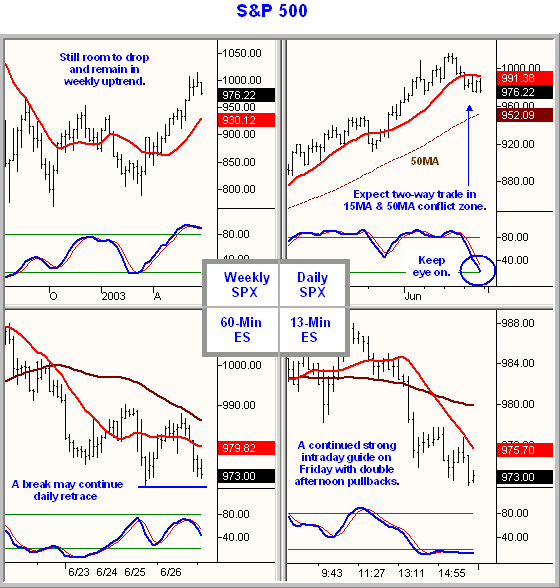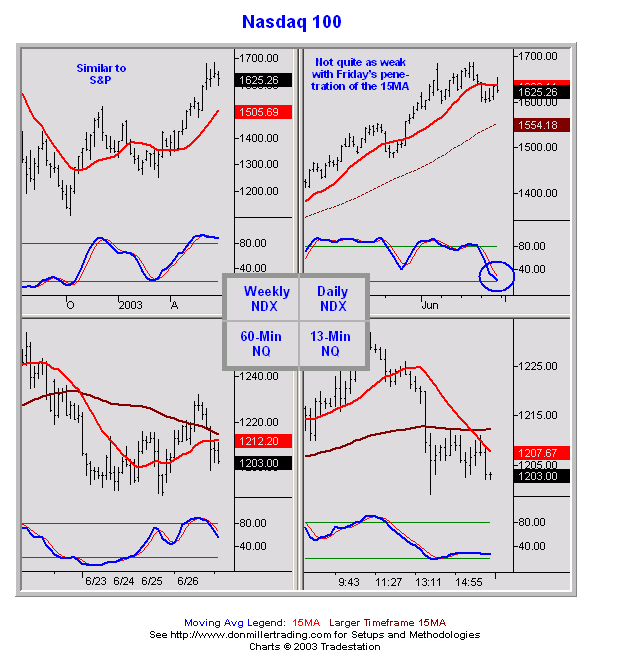How I Combine Longer Timeframes
Welcome
to the first weekend edition of Trading The E-Minis And SPYs.
As I mentioned on
Monday, after
two years of doing daily market and trading analyses, we’ve moved to
Saturdays as we enter the summer to continue our ongoing mission,
while providing for some added flexibility at this end.
One of the benefits of the change is that it will provide us with an
opportunity to delve into various issues with emphasis that simply
isn’t possible with a midday piece prepared in the haste of a trading
day. In fact, time seems to be moving so slowly as I write this on
Friday night, that the Red Sox have been up to bat now for 50 minutes,
have sent 19 men to the plate (the first ten reaching without an out),
we’ve seen 91 pitches, scored 14 runs, and they just made the final
out of the
first inning …
ironically, being thrown out at the plate. Yet
this remains a trading column, so let’s get to work.
I must first say that writing this piece feels a bit different. Since
I don’t believe in ghost-writing or repetitive cut-and-paste pieces,
doing a midday piece from the heart always required an interruption in
the daily routine, which, while I got used to it, always resulted in a
somewhat less-than-optimal divided focus. Yet based on your feedback,
we’ll keep much of the past content consistent, while adding greater
in-depth chart analysis and dialogue to help you plan the current week
from both a technical and psychological perspective.
With respect to the charts, we’ll continue our theme of reviewing the
markets from a multiple timeframe perspective, providing views of the
S&P and Nasdaq indices from weekly, daily, hourly, and 13-minute
timeframes. I’ll also be making many of my technical notes within the
charts themselves, which will leave the wordier portion to address the
equally — if not more important — issues of trader issues.
Let’s first review the charts:


It’s
now 17-1 in the top of the third … the Florida Marlins must feel
similar to intraday longs and bottom fishers late in Friday’s session!
As noted above, we’ve added the
weekly perspective to our traditional daily/60/13 combination. In
doing so, it’s a good time to note that the methods discussed in the
video and simulations apply to swing trading as much as they do
intraday activity. For while many of the demonstrated timeframes are
intraday to provide a faster learning experience, it’s the
interpretation of the combination of timeframes that is key, whether
it’s a one/three/13 or a 60/daily/weekly combo.
An example is the use of the daily ES 15MA downtrend support (my term
for long resistance) which surfaced during both Thursday and Friday’s
session, as well an current expectation that the S&P will likely trade
back and forth a bit between the current daily and weekly trend
conflicts. While the latter scenario typically frustrates the heck out
of multi-day trend traders, such conflicts can provide a fertile
trading ground for astute oscillation traders until the defined range
breaks, and such is the expectation over the next week or so.
Since we’re talking about change this week, the time is well-suited to
discuss the mental issue of closure for those who may be struggling.
For everyone goes through slumps — perhaps not all Marlin-esque (it’s
now 19-1 in the fourth) — yet both market and trader rhythms
fluctuate over time with periods of trading existing that range from
slightly sloppy to downright ugly.
Techniques I encourage and have used at this end include everything
from the simplicity of changing the background color of your charts,
to physically closing your daily, weekly, or month books as if it were
the end of your designated “accounting period.” Far from being
superstitious, the rather simple changes are designed to remind you
that every trade, day, week, month, and year are unique and unrelated
to the past.
I remember one rather troublesome morning a few years ago when I
couldn’t get into the market rhythm for the life of me, and decided to
close my weekly books at noon of that particular trading day … which
was on a Tuesday! I then went to lunch, not planning to return for
the day, after which I returned to my office with a refreshed attitude
and decided to begin the new “week” that afternoon. The day resulted
in a net positive trade … albeit barely … after a morning that
easily fell into the “should have stayed in bed” category.
Perhaps the Marlins will think about coming to the game tomorrow with
their uniform names spelled backwards. Then again, it’s now 19-5
and maybe the comeback is already on.
Good Trading and
Have a Great Week!
